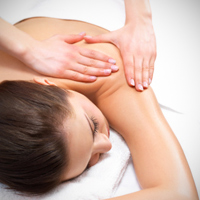

Moderate pressure massage is among the massage therapies that can help relieve rheumatoid arthritis pain. Know what to look for and what to avoid with massage.

Massage isn't just an occasional feel-good indulgence — it can be a great form of RA treatment. Need proof? According to research published in the May 2013 issue of the journal Complementary Therapy in Clinical Practice, study participants reported relief from pain and stiffness after four once-a-week moderate-pressure massages on arms affected by rheumatoid arthritis, supplemented with daily self-massage at home. They also reported having a stronger grip and a greater range of motion than those who were given only a light-touch massage.
Earlier research, published in 2011 in the same journal, found that massage had similar benefits for RA pain in the hands and also reported that the combination of weekly massage therapy and daily self-massage led to improved mood and better sleep.
Massage therapy expert Tiffany Field, PhD, founder and director of the Touch Research Institute at the University of Miami Miller School of Medicine in Florida, led both studies. For the research that looked at massage for RA pain on the arms, she defined moderate pressure as “pressure that moves the skin.” Each person has his own comfort level. “Massage therapists will ask you where you feel pain and also whether the pressure they are applying is enough,” Field said. If you want to duplicate the results of her research, aim for pressure that is firm but not so deep as to be painful.
Though massage has benefits for people with rheumatoid arthritis, the question of how long those benefits might last remains unanswered. You might need ongoing massage treatments or tune-up visits when your pain and stiffness return.
“Massage has been shown to be useful in reducing pain temporarily,” explained Audrey Lynn Millar, PT, PhD, a physical therapy professor at the School of Health Sciences of Winston-Salem State University in North Carolina. And best of all, she added, there's no reason not to include massage as part of your RA treatment.
Although there are many types of massage, only two — moderate-pressure massage and myofascial release — have research support for pain relief for RA, but you can explore others as well. Consider these four massage choices:
Myofascial release. This is a style of hands-on therapy that involves longer pressure on select areas of the body to break up tight connective tissue. According to a 2011 study published in the International Journal of Therapeutic Massage and Bodywork, this style of therapy, applied three times a week for two weeks, can provide relief of pain and other RA symptoms. As part of the research, Carol Davis, PT, professor emerita of physical therapy at the University of Miami Miller School of Medicine, studied the use of myofascial release in the treatment of various conditions, including rheumatoid arthritis. She explained that the extended pressure (more than three minutes) applied in targeted locations on the body helps change the underlying structure of connective tissue, correcting structural changes that could be contributing to pain. Myofascial release could be effective by stimulating blood flow and triggering the body’s natural anti-inflammatory actions, she suggested.
Swedish massage. The best-known massage technique, Swedish massage uses long strokes of varying pressure to ease and unknot muscles. You might ask for a moderate-pressure version of this style to achieve results similar to those in the research studies. Massage therapists who use this style might include lotions or oils during the session.
Hot stone massage. This style of massage combines hands-on therapy for knotted muscles with the application of hot stones that can relax muscles and ease pain. Hot stone massage is sometimes offered at spas. Millar advised caution with heat, however, as it might aggravate inflamed joints.
Deep-tissue massage. Deep-tissue massage uses intense pressure and tissue manipulation to address stiffness and soreness. However, if the pressure seems too great, don’t continue with this style of massage.
Try these strategies to get the best massage:
Ask for referrals. Talk to your medical team, physical therapist, or others with rheumatoid arthritis to get a recommendation for a massage therapist.
Look for experience. “You want a massage therapist who understands the rheumatoid arthritis disease process,” Millar noted.
Explain your pain. Be specific about the joints that hurt and how much they hurt. For example, even though moderate-pressure massage is helpful, Millar warned that deep pressure or high heat applied to joints that are actively inflamed could actually make pain and swelling worse.
Drink lots of water. Davis explained that massage with any degree of pressure will affect the water flow in your body and will be more effective if you are well-hydrated. “We recommend drinking half your weight in ounces of water,” she said. So if you weigh 150 pounds, aim for 75 ounces of water daily.
Ask for self-massage pointers. “You can reach most areas on your body,” said Field. Daily self-massage reinforces the pain relief.
A massage treatment, whether weekly or more frequently, could be a soothing addition to your RA treatment plan.
Copyright © www.orthopaedics.win Bone Health All Rights Reserved